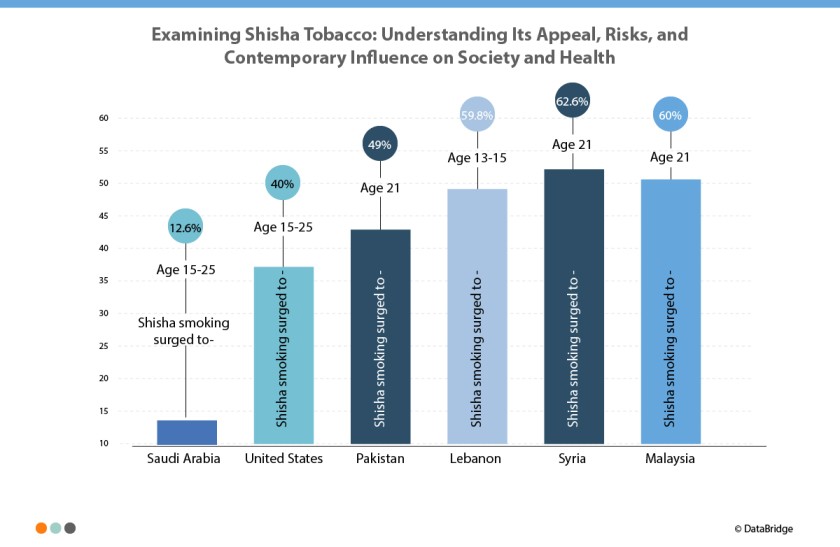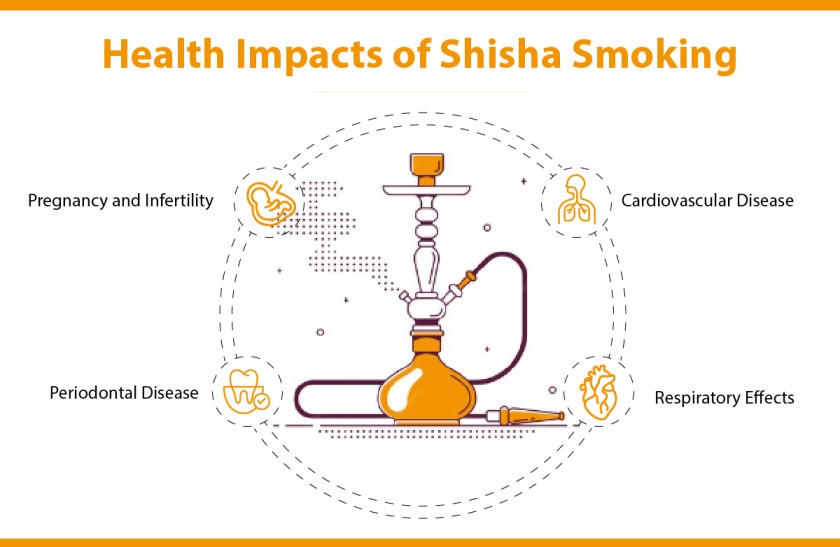Introduction
Shisha tobacco, also known as hookah or waterpipe tobacco, boasts a rich cultural heritage originating from ancient Persia and India. Its global popularity, particularly among young adults, highlights a concerning trend amidst its allure: a complex interplay of health risks and societal impacts.
Tobacco consumption, a preventable cause of morbidity and mortality worldwide, disproportionately affects low and middle-income countries. Projections suggest a staggering rise in tobacco-attributable deaths, doubling from 3.4 million to 6.8 million between 2002 and 2030 in these regions. Currently, tobacco claims about 5 million lives annually globally, with half of today's smokers facing premature death. Shisha smoking, a practice dating back centuries, contributes significantly to this alarming trend.
Explore the Tobacco Market in-depth analysis with Data Bridge Market Research. Access the latest trends, forecasts, and comprehensive analysis. Unlock your market potential now! Visit today for expert insights and strategies.
https://www.databridgemarketresearch.com/es/reports/global-tobacco-products-market
Shisha, also known as Narghile, Hubble bubble, or water pipe, involves smoking tobacco where vapor passes through water before inhalation. Originating in the Eastern Mediterranean, shisha's popularity now spans Western countries such as Australia, the U.K., Canada, and the U.S. Its growing prevalence is notable among youth, including university and high school students.
Public health officials have classified shisha as a global threat, likening it to an epidemic. Despite popular misconceptions about its safety, tobacco smoke from shisha contains over 4800 chemicals, including 69 carcinogens and numerous tumor promoters. The belief that shisha has lower nicotine content than cigarettes, coupled with the misconception that water filtration eliminates harmful chemicals, contributes to its appeal despite the health hazards.
This review underscores the emerging peril of shisha tobacco in the tobacco epidemic, emphasizing the need for research on water pipe epidemiology, health effects, and public policy. Addressing these complexities is crucial to combat the rising tide of shisha-related health risks and societal impacts.
Epidemiology of Shisha Smoking: Global Trends
U.S.
Shisha smoking prevalence in the U.S. surged to 40% between 2005 and 2008, with studies at various universities revealing alarming figures. Surveys conducted at the University of San Diego and Wayne University reported prevalence rates of 24.5% and 10%, respectively, while Maziak W estimated a global prevalence of 6-39%. Braun RE's study showed that 15.4% of students had previously smoked shisha, with 6% doing so within the past 30 days.
Non-U.S. Prevalence: Pakistan
In Pakistan, limited research on shisha prevalence revealed concerning figures. Studies among medical and dental students in Karachi showed rates of 22.7% and 53.6% respectively. Surveys across multiple universities indicated a prevalence of 49%, with 61% of shisha smokers predominantly smoking occasionally. In semi-urban communities of Karachi, 19% of tobacco smokers were found to be shisha users.
Worldwide Prevalence
Globally, shisha smoking is on the rise. Lebanon's youth tobacco survey found that 59.8% of 13-15-year-olds had smoked shisha in the past month, compared to only 10% who smoked cigarettes. In Saudi Arabia, studies indicated a prevalence of 12.6% among college students. Similar rates were found in Malaysia and Syria, where 60% and 62.6% of respondents respectively had tried shisha.
Gender and Age Distribution
In the U.S. and Saudi Arabia, shisha smokers are predominantly male, with ages between 15-25 years. Syria and Pakistan exhibit similar trends, with males dominating shisha use at ages around 21 years. However, in Jordan, more females than males are found to smoke shisha.
These epidemiological findings highlight the widespread prevalence of shisha smoking across various demographics and regions, underscoring the urgent need for targeted interventions and public health policies to address this growing global health concern.
Comparison of Shisha Smoke with Cigarette Smoke
In a single smoking session of 10 g of molasses tobacco paste with 1.5 quick-lighting charcoal disks applied to the narghile head:
- Shisha smoke contained 2.94 mg Nicotine, 802 mg tar, and 145 mg CO, along with higher quantities of chrysene, phenanthrene, and flouranthrene compared to a single cigarette
- Shisha smoking involves about 171 puffs of 0.53 L volume and 2.6 s duration, with a 17 s inter-puff interval, approximately 10 times more puffs and volume than a cigarette
- The burning temperature for shisha is about 900°C compared to 450°C for a cigarette
- While peak nicotine concentration is similar between cigarette and shisha, the longer duration of shisha use results in significantly greater effective nicotine exposure
- Using a pharmacokinetics model, shisha smokers were exposed to 1.7 times the nicotine dose compared to cigarette smokers, with a nicotine AUC of 418 ng/ml-min for shisha and 243 ng/ml-min for a cigarette
Discover in-depth insights on the Shisha Tobacco Market. Visit Data Bridge Market Research for the latest trends, forecasts, and comprehensive analysis. Unlock your market potential today!
https://www.databridgemarketresearch.com/es/reports/global-shisha-tobacco-market
Social Media Influence on Shisha Smoking
Since 2003, social media platforms such as Facebook, YouTube, and Instagram have proliferated, shaping online interactions and content creation. Studies have highlighted social media's role in promoting shisha smoking behavior, particularly among youth, who comprise a significant portion of users. Ilakkuvan et al. found that 88% of individuals aged 18-29 use social media daily, with 23% having tried shisha smoking, often after encountering related content online. Singh et al. (2017) and Maziak et al. (2015) argue that social media plays a pivotal role in influencing youth to initiate shisha smoking. This study aims to systematically analyze shisha-related content on social media, contributing to public health interventions and guiding future research efforts.
Shisha Smoking: Health Risks and Prevention
Shisha smoking, often underestimated for its health risks, contains harmful chemicals akin to cigarette smoke, including nicotine, tar, and carbon monoxide. Research reveals that a single shisha session exposes individuals to higher toxin levels than a pack of cigarettes. Despite the belief in water filtration's efficacy, it fails to eliminate these hazards, leading to respiratory issues, cardiovascular disease, and cancer with long-term use.
Health Impacts
- Respiratory Effects: Prolonged shisha smoking causes acute carbon monoxide poisoning and is linked to chronic obstructive pulmonary disorder (COPD) and bronchitis
- Cardiovascular Disease: Cardiovascular disease raises heart rate, blood pressure, and is linked to coronary artery disease and metabolic syndrome. According to WHO's 2020 update, ischemic heart disease caused 16% of global deaths, with mortality rising to 8.9 million in 2019. This surge has heightened the demand for cardiovascular ultrasound systems for diagnostics, fueling growth in this market
Periodontal Disease: Similar risks to cigarette smoking, adversely affecting periodontal health
- Pregnancy and Infertility: Associated with low birth weight, pulmonary issues in newborns, and male infertility
Prevention Strategies
- Health Education: Raise awareness about shisha's harmful effects, especially targeting youth in educational institutions
- Service Approach: Provide counseling and information about health risks by trained healthcare professionals
- Regulatory Measures: Advocate for bans in public places, strong health warnings on shisha products, and increased taxation, following WHO's MPOWER measures
Conclusion: Addressing the Shisha Epidemic
Shisha tobacco, deeply rooted in cultural traditions, has evolved into a global phenomenon with profound health implications. Epidemiological data reveal its pervasive presence across diverse demographics and regions, reflecting a pressing need for targeted interventions. Despite misconceptions about its safety, shisha smoke contains numerous harmful chemicals, posing significant health risks comparable to cigarette smoking. Social media platforms exacerbate its allure, particularly among impressionable youth.
To combat this emerging epidemic, concerted efforts are imperative. Public health initiatives must prioritize education, regulation, and enforcement. Raising awareness about shisha's health risks, implementing stringent regulations, and leveraging taxation measures are crucial steps. Equally vital is addressing social media's role in promoting shisha smoking behaviour. Through employing multifaceted strategies, we can mitigate the escalating health risks and societal impacts associated with shisha tobacco, safeguarding public health for generations to come.














